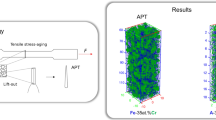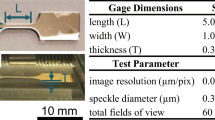Abstract
Cross-correlation of electron backscatter diffraction patterns has been used to generate stress and strain maps of a single crystal of tetragonal barium titanate (BaTiO3) containing bundles of small, (0.2–5) μm, a- and c-domains separated by 90° domain boundaries. The strains peaked at the domain boundaries, and approximately equal, but opposite, values were observed in the a- and c-domains; the peak strain magnitudes were slightly less than half the tetragonal distortion of BaTiO3, about 0.004, consistent with a tendency to a cubic structure at domain boundaries. The strain state was dominated by two normal strains: in-plane, perpendicular to domain wall intersections with the surface, and out-of-plane, perpendicular to the surface. In distinction to larger, lamellar domains, significant shear strains were also observed. Stress maps were constructed from strain maps using a method that does not require zero stress at reference locations. Peak in-plane normal stresses of approximately 700 MPa were observed. The variation of the stress component parallel to the domain walls was used to determine numerically a microstructurally based stress intensity factor for crack propagation perpendicular to the domain walls. The conditions for stable micro-crack formation in the microstructural stress field and unstable crack propagation under the action of a superposed applied stress were considered in the context of multi-layer ceramic capacitor reliability.










Similar content being viewed by others
References
Kishi H, Mizuno Y, Chazono H (2003) Base-metal electrode-multilayer ceramic capacitors: past, present and future perspectives. Jpn J Appl Phys Part 1(42):1–15
Pan MJ, Randall CA (2010) A brief introduction to ceramic capacitors. IEEE Electr Insul Mag 26:44–50
TDK Product Center, Multilayer Ceramic Chip Capacitors, https://product.tdk.com/info/en/products/capacitor/ceramic/mlcc/index.html. Accessed 8 Nov 2016
Global and China Multi-layer Ceramic Capacitor (MLCC) Industry Report, 2015–2018. http://www.prnewswire.com/news-releases/global-and-china-multi-layer-ceramic-capacitor-mlcc-industry-report-2015-2018-300184096.html. Accessed 8 Nov 2016
Davis C, Maloy S, and Wegman J (2000) Common cracking modes in surface mount multilayer ceramic capacitors. http://www.digikey.com/en/pdf/t/tdk/common-cracking-modes. Accessed 8 Nov 2016
Chen K-Y, Huang C-W, Wu M, Wei W-CJ, Hsueh C-H (2014) Advanced characterization of mechanical properties of multilayer ceramic capacitors. J Mater Sci: Mater Electron 25:627–634
den Toonder JM, Rademaker CW, Hu C-L (2003) Residual stresses in multilayer ceramic capacitors: measurement and computation. J Electronic Packaging 125:506–511
Kwei GH, Lawson AC, Billinge SJL, Cheong SW (1993) Structures of the ferroelectric phases of barium-titanate. J Phys Chem 97:2368–2377
Arlt G, Sasko P (1980) Domain configuration and equilibrium size of domains in BaTiO3 ceramics. J Appl Phys 51:4956–4960
Pramanick A, Jones JL, Tutncu G, Gjosh D, Stoica AD, An K (2012) Strain incompatibility and residual strains in ferroelectric single crystals. Sci Reports 2:929
Howell JA, Vaudin MD, Cook RF (2014) Orientation, stress, and strain in an (001) barium titanate single crystal with 90° lamellar domains determined using electron backscatter diffraction. J Mater Sci 49:2213–2224
Azough F, Al-Saffar R, Freer R (1998) A transmission electron microscope study of commercial X7R-type multilayer ceramic capacitors. J Eur Ceram Soc 18:751–758
Forsbergh PW (1949) Domain structures and phase transitions in barium titanate. Phys Rev 76:1187–1201
Merz WJ (1954) Domain formation and domain wall motions in ferroelectric in BaTiO3 single crystals. Phys Rev 95:690–698
Tsai F, Cowley JM (1992) Observation of ferroelectric domain boundaries in BaTiO3 single crystals by reflection electron microscopy. Ultramicroscopy 45:43–53
Park BM, Chung SJ, Kim HS, Si WM, Dudley M (1997) Synchrotron white-beam X-ray topography of ferroelectric domains in a BaTiO3 single crystal. Philos Mag A 75:611–620
Rogan RC, Tamura N, Swift GA, Ustundag E (2003) Direct measurement of triaxial strain fields around ferroelectric domains using X-ray microdiffraction. Nature Mater 2:379–381
Holt M, Hassani K, Sutton M (2005) Microstructure of ferroelectric domains in BaTiO3 observed via X-ray microdiffraction. Phys Rev Lett 95:085504
DeVries RC, Burke JE (1957) Microstructure of barium titanate ceramics. J Am Ceram Soc 40:200–206
Burfoot JC (1959) A possible model for the switching of barium titanate crystals. Proc Phys Soc 73:641–649
Bursill LA, Lin PJ (1984) Microdomains observed at the ferroelectric/paraelectric phase transition of barium titanate. Nature 311:550–552
Jun C, Fan C-G, Qi L, Duan F (1988) Transmission electron microscope studies of para-ferroelectric transitions in BaTiO3 and KNbO3. J Phys C: Solid State Phys 21:2255–2266
Park BM, Chung SJ (1994) Optical, electron microscopic, and X-ray topographic studies of ferroic domains in barium titanate crystals grown from high-temperature solution. J Am Ceram Soc 77:3193–3201
Cheng S-Y, Ho N-J, Lu H-Y (2006) Transformation-induced twinning: the 90° and 180° ferroelectric domains in tetragonal barium titanate. J Am Ceram Soc 89:2177–2187
Mase WE (1970) Continuum Mechanics. McGraw-Hill, New York
Nye JF (1979) Physical Properties of Crystals their representation by tensors and matrices. Oxford University Press, Oxford
Berlincourt D, Jaffe H (1958) Elastic and piezoelectric coefficients of single-crystal barium titanate. Phys Rev 111:143–148
Wilkinson AJ, Meaden G, Dingley DJ (2006) High resolution mapping of strains and rotations using electron backscatter diffraction. Mater Sci Technol 22:1271–1278
Vaudin MD, Gerbig TB, Stranick SJ, Cook RF (2008) Comparison of nanoscale measurements of strain and stress using electron back scattered diffraction and confocal Raman microscopy. Appl Phys Let 93:193116
Vaudin MD, Stan G, Gerbig YB, Cook RF (2011) High resolution surface morphology measurements using EBSD cross-correlation techniques and AFM. Ultramicroscopy 111:1206–1213
Friedman LH, Vaudin MD, Stranick SJ, Stan G, Gerbig YB, Osborn WA, Cook RF (2016) Assessing strain mapping by electron backscatter diffraction and confocal Raman microscopy using wedge-indented Si. Ultramicroscopy 163:75–86
Wilkinson AJ (2006) High resolution measurements of strain and tilt distributions in SiGe mesas using electron backscatter diffraction. Appl Phys Let 89:241910
Vaudin MD, Osborn WA, Friedman LH, Gorham JM, Cook RF (2015) Designing a standard for strain mapping: HR-EBSD analysis of SiGe thin film structures on Si. Ultramicroscopy 148:94–104
Lawn BR (1993) Fracture of Brittle Solids-Second Edition. Cambridge University Press, Cambridge
Michaels CA, Cook RF (2016) Determination of residual stress distributions in polycrystalline alumina using fluorescence microscopy. Mater Design 107:478–490
Cook RF, Fairbanks CJ, Lawn BR, Mai Y-W (1987) Crack resistance by interfacial bridging: its role in determining strength characteristics. J Mat Res 2:345–356
deWith G (1993) Structural Integrity of ceramic multilayer capacitor materials and ceramic multilayer capacitors. J Eur Ceram Soc 12:323–336
Rattanachan S, Miyashita Y, Mutoh Y (2005) Fracture toughness of BaTiO3 and BaTiO3-Al2O3 composite under electric field. In: Bradt RC, Munz D, Sakai M, White KW (eds) Fracture Mechanics of Ceramics. Springer, New York, pp 297–305
Galal Yousef S, Rödel J, Fuller ER Jr, Zimmermann A, El-Dasher BS (2005) Microcrack evolution in alumina ceramics: experiment and simulation. J Am Ceram Soc 88:2809–2816
Yoneda Y, Kohmura Y, Suzuki Y, Hamazaki S, Takashige M (2004) X-ray diffraction topography on a BaTiO3 crystal. J Phys Soc Jpn 73:1050–1053
Dennis MD, Bradt RC (1974) Thickness of 90 degrees ferroelectric domain walls in (Ba, Pb)TiO3 single crystals. J Appl Phys 45:1931–1933
Zhang X, Hashimoto T, Joy DC (1992) Electron holographic study of ferroelectric domain walls. Appl Phys Let 60:784–786
Dawber M, Rabe KM, Scott JF (2005) Physics of thin-film ferroelectric oxides. Rev Modern Phys 77:1083–1130
Catalan G, Seidel J, Ramesh R, Scott JF (2012) Domain wall nanoelectronics. Rev Modern Phys 85:119–156
Su Y, Landis CM (2007) Continuum thermodynamics of ferroelectric domain evolution: theory, finite element implementation, and application to domain wall pinning. J Mech Phys Solids 55:280–305
Woldman AY, Landis CM (2016) Phase-field modeling of ferroelectric to paraelectric phase boundary structures in single-crystal barium titanate. Smart Mater 25:035033
Ma W, Cross LE (2006) Flexoelectricity of barium titanate. Appl Phys Let 88:232902
Zubko P, Catalan G, Tagantsev AK (2013) Flexoelectric effect in solids. Ann Rev Mater Res 43:387–421
Acknowledgments
Certain commercial equipment, instruments, and software are identified in this paper in order to specify the experimental procedure adequately. Such identification is not intended to imply recommendation or endorsement by the National Institute of Standards and Technology, nor is it intended to imply that the equipment or software identified is necessarily best available for the purpose.
Author information
Authors and Affiliations
Corresponding author
Electronic supplementary material
Below is the link to the electronic supplementary material.
Rights and permissions
About this article
Cite this article
Howell, J.A., Vaudin, M.D., Friedman, L.H. et al. Stress and strain mapping of micro-domain bundles in barium titanate using electron backscatter diffraction. J Mater Sci 52, 12608–12623 (2017). https://doi.org/10.1007/s10853-017-1355-4
Received:
Accepted:
Published:
Issue Date:
DOI: https://doi.org/10.1007/s10853-017-1355-4




